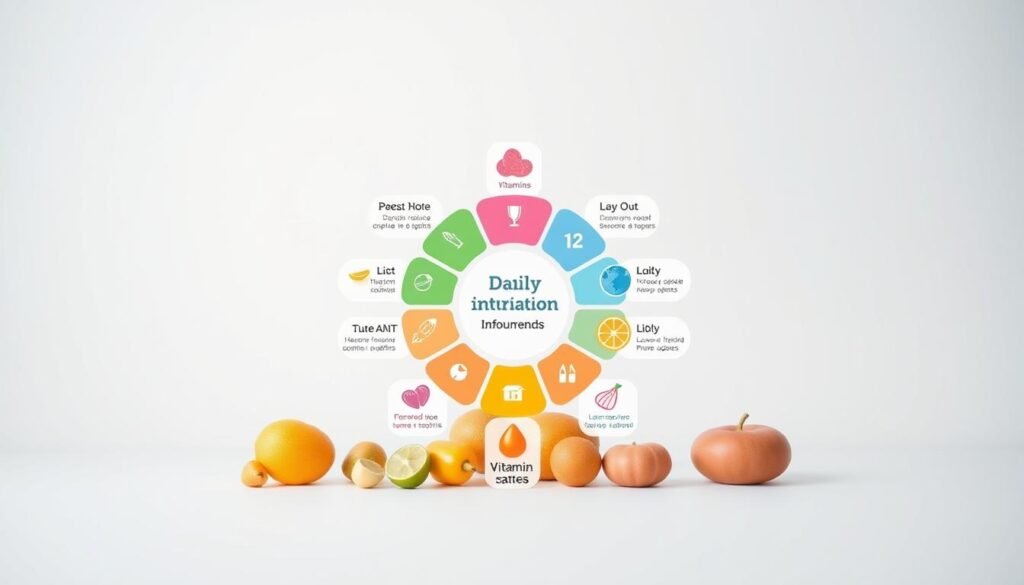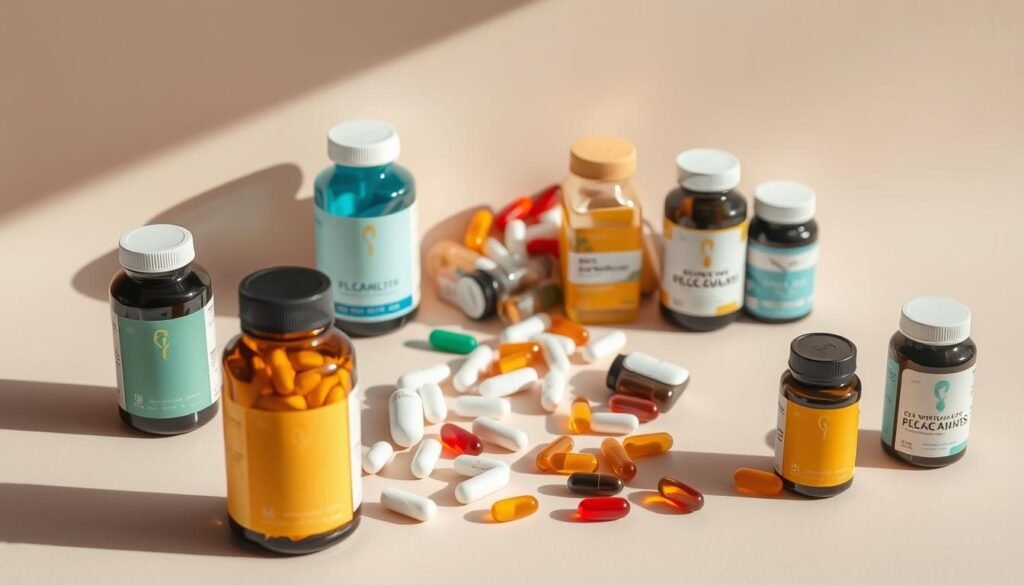Did you know your body can’t produce the micronutrients it needs to function properly? These tiny powerhouses fuel everything from energy levels to immune support. Yet, most people don’t realize how critical they are until deficiencies arise.
Science has proven that micronutrients—like iron, calcium, and vitamin D—play a non-negotiable role in wellness. For over a century, research has shown their impact on metabolism, bone strength, and even mental clarity.
The National Academy of Medicine sets strict guidelines, called Dietary Reference Intakes (DRIs), for over 40 nutrients. These standards help ensure your body gets what it needs to thrive. Without them, even small gaps can lead to noticeable health setbacks.
Key Takeaways
- Your body relies on external sources for micronutrients.
- Deficiencies can disrupt energy, immunity, and more.
- DRIs provide science-backed intake recommendations.
- Balanced diets prevent most nutrient shortfalls.
- Supplements help when dietary intake falls short.
What Are Vitamins and Minerals?
Vitamins and minerals are the unseen architects of your body’s daily functions. These micronutrients power everything from energy production to immune defense, yet they’re often overlooked until deficiencies arise.
Definition and Importance
Vitamins are organic compounds your body needs in small amounts. They include A, B-complex, C, D, E, and K. Minerals, like calcium and iron, are inorganic elements absorbed from soil and water.
Fat-soluble vitamins (A, D, E, K) store in fatty tissues, while water-soluble ones (B, C) require daily replenishment. This difference impacts how you plan meals for optimal intake.
Micronutrients vs. Macronutrients
Micronutrients are measured in milligrams or micrograms, unlike macronutrients (carbs, proteins) needed in grams. For example, you might eat 50g of protein but only 15mg of zinc daily.
History reveals the stakes: Scurvy (vitamin C deficiency) plagued sailors, while rickets (vitamin D lack) affected children’s bone growth. These examples underscore why balanced nutrients matter.
Types of Vitamins: Fat-Soluble and Water-Soluble
Not all vitamins behave the same way in your body—some linger while others vanish quickly. This difference comes down to solubility, which determines how nutrients are absorbed, stored, and used.

Fat-Soluble Vitamins
Fat-soluble vitamins (A, D, E, K) hitch rides with dietary fats to reach your liver and fatty tissues. Unlike their water-soluble counterparts, these can remain stored in your body for weeks or months.
Vitamin A supports vision and immunity, while D promotes calcium absorption for bone health. Vitamin E acts as an antioxidant, and K ensures proper blood clotting. Since these accumulate in your system, excessive intake—especially through supplements—can reach toxic levels.
Water-Soluble Vitamins
The water-soluble vitamins (B-complex and C) dissolve in bodily fluids and generally aren’t stored. Your body uses what it needs and excretes excess through urine, requiring daily replenishment from foods.
This group includes eight B vitamins that convert food into energy, plus vitamin C for collagen production. Cooking can destroy 20-40% of these nutrients, especially when boiling. The exception is B12, which your liver can store for years.
Unlike fat-soluble types, water-soluble vitamins rarely cause toxicity. However, proper intake remains crucial since deficiencies can develop quickly without consistent dietary sources.
Key Minerals Your Body Needs
Minerals are the silent workers behind your body’s most vital processes. Unlike vitamins, these inorganic elements come from soil and water, yet their impact is profound.
Major Minerals: Builders and Regulators
Calcium makes up 99% of your bones and teeth. It also helps regulate your heartbeat. Adults need 1,000–1,200 mg daily, but many fall short.
Iron carries oxygen in your blood. Deficiency affects 1.6 billion people globally, causing fatigue and anemia. Heme iron (from meat) absorbs better than plant-based non-heme iron.
Potassium balances fluids and nerves. Low levels lead to muscle cramps. Aim for 2,600–3,400 mg daily from bananas or potatoes.
Trace Minerals: Small but Mighty
Zinc powers immunity and wound healing. Shellfish and whole grains are top sources. Just 8–11 mg daily keeps defenses strong.
Iodine supports thyroid function. Without it, your metabolism slows, and goiter can develop. Seaweed and fish are rich in iodine.
Selenium acts as an antioxidant. Brazil nuts provide a week’s worth in one serving. The USDA recommends 55 mcg daily.
Pairing vitamin C with plant-based iron boosts absorption. For calcium, add magnesium-rich nuts or leafy greens. Small tweaks maximize mineral benefits.
How Essential Vitamins and Minerals Support Overall Health
From fighting infections to powering thoughts, micronutrients drive critical bodily functions. These tiny compounds work synergistically to keep systems running smoothly, often with dramatic effects on longevity and vitality.

Boosting Immunity and Energy Levels
Zinc and vitamin C form a frontline defense against pathogens. Studies show vitamin C triples iron absorption, which is vital for immune cell production. Deficiencies in these nutrients increase susceptibility to disease.
B vitamins convert food into ATP—your body’s energy currency. Without adequate B6, B12, or folate, mitochondrial function slows, causing fatigue. Riboflavin (B2) also helps recycle glutathione, a master antioxidant.
Promoting Bone, Heart, and Brain Health
Calcium and vitamin D create a dense bone matrix. Vitamin D enhances calcium uptake, while magnesium directs it to bones instead of soft tissues. Pairing them with healthy fats maximizes absorption.
Potassium regulates blood pressure by counteracting sodium’s effects. Omega-3s and vitamin D together reduce cardiovascular risks by 30%, per clinical trials. For the brain, B12 and omega-3s prevent cognitive decline by shielding neurons.
Top Food Sources for Essential Vitamins and Minerals
Your plate holds the key to unlocking your body’s full nutrient potential. Choosing the right food sources ensures you meet daily needs without relying solely on supplements. Here’s how to maximize intake through diet.
Best Sources of Fat-Soluble Vitamins
Vitamin A thrives in liver (6,500 IU per gram) and sweet potatoes (1,100 IU per gram). For vitamin D, 3oz of salmon delivers 100% of the RDA. Almonds and sunflower seeds pack vitamin E, while leafy greens like kale provide vitamin K.
Pair these with healthy fats (olive oil, avocado) to boost absorption. Unlike water-soluble vitamins, excess amounts store in the body, so moderation matters.
Best Sources of Water-Soluble Vitamins
Red peppers outshine oranges with 95mg of vitamin C per 100g. For B vitamins, prioritize whole grains, eggs, and legumes. Fortified cereals are a vegan-friendly food source for B12.
Steam vegetables instead of boiling to retain up to 50% more nutrients. Water-soluble vitamins exit the body quickly, so include these daily.
Mineral-Rich Foods to Include in Your Diet
Sardines with bones offer 240mg of calcium per 85g—more than a cup of kale. For iron, choose heme sources like lean beef (better absorbed) or pair spinach with citrus for non-heme iron uptake.
Fish (tuna, cod) provides iodine, while Brazil nuts deliver a week’s selenium in one serving. Yogurt (dairy) and cashews (nuts) round out mineral needs.
Daily Requirements and Recommended Intakes
Navigating daily nutrient needs isn’t one-size-fits-all—age, gender, and life stage all play a role. The National Academy of Medicine sets science-backed benchmarks called Dietary Reference Intakes (DRIs) to guide optimal intake. These prevent deficiencies while avoiding excess.

Dietary Reference Intakes by Age and Gender
DRIs include four categories: EAR (minimum needs), RDA (covers 97% of people), AI (estimated adequacy), and UL (safe upper limit). For example, men aged 19–30 need 900mcg of vitamin A daily, while women require 700mcg.
Iron needs differ sharply: women (18mg/day) need double men’s intake (8mg) due to menstruation. Pregnancy spikes folate needs to 600mcg/day to prevent birth defects.
Understanding RDA and AI Values
When research is limited, AI replaces RDA. Vitamin K uses AI (90–120mcg/day) due to insufficient data. For calcium, seniors over 50 need 1,200mg/day—200mg more than younger adults—to combat bone loss.
Exceeding ULs risks toxicity. Vitamin D’s UL is 4,000 IU/day. A balanced diet rarely hits these limits, but supplements can.
| Nutrient | Men (19–30) | Women (19–30) |
|---|---|---|
| Vitamin A | 900mcg | 700mcg |
| Iron | 8mg | 18mg |
| Calcium | 1,000mg | 1,000mg |
Signs of Vitamin and Mineral Deficiencies
Your body sends clear signals when it lacks crucial nutrients—are you listening? From brittle nails to persistent fatigue, these warnings often go unnoticed until they escalate. Recognizing them early can prevent long-term damage.
Common Deficiency Symptoms
Cracks at mouth corners (cheilosis) signal low riboflavin (B2). Bleeding gums may indicate vitamin C deficiency, historically linked to scurvy. Pale skin and dizziness often point to low iron, affecting blood oxygen levels.
Neurological signs are equally telling. Tingling hands/feet (peripheral neuropathy) suggest B12 gaps, common among vegans. Confusion or memory lapses could mean low folate or magnesium.
Long-Term Health Risks
Ignoring deficiencies invites disease. Chronic low iron causes anemia, straining organs. Vitamin D gaps (42% of U.S. adults) raise osteoporosis risk, especially in postmenopausal women.
Untreated B12 deficiency may permanently damage nerves. Iodine lack disrupts thyroid function, slowing metabolism. Testing (serum ferritin, 25-OH-D) clarifies gaps before they worsen.
When to Consider Supplements
Nearly 35% of Americans rely on multivitamins to fill nutritional gaps. While food should always come first, certain situations demand extra support. Knowing when and how to choose the right products can make all the difference.

Who Benefits Most from Supplements?
Pregnant women need 600mcg of folic acid daily to prevent birth defects. Seniors often struggle to absorb B12 from food, making supplements crucial. Vegans require fortified products or B12 injections to meet their 2.4mcg daily need.
Bariatric surgery patients face malabsorption issues. Athletes with intense training may need extra iron or magnesium. Always consult a doctor before starting new regimens.
Smart Supplement Selection
Tablets typically absorb better than gummies, which often lack key nutrients. Look for third-party certifications like USP or NSF to ensure quality. Avoid megadoses—excess vitamin A can harm your liver.
Age and gender matter. Prenatal blends include iron and folate, while senior formulas focus on bone health. Pair fat-soluble vitamins (A, D, E, K) with meals for optimal uptake.
Tips for a Balanced Diet Rich in Essential Nutrients
Crafting a nutrient-rich diet doesn’t require complex formulas—just smart choices. By combining the right foods and cooking methods, you can maximize absorption and avoid deficiencies. Start with the USDA’s MyPlate guideline: fill half your plate with fruits and vegetables.
Meal Planning Strategies
A 7-day plan ensures variety. Monday: spinach omelet (vitamin K + healthy fats) with whole-grain toast. Tuesday: lentil soup (iron) with bell peppers (vitamin C). Rotate proteins, colors, and textures to cover all bases.
Budget-friendly swaps matter. Frozen berries match fresh in nutrients but cost less. Soaking beans reduces phytic acid, unlocking more minerals. Sous-vide cooking preserves 90% of vitamins compared to boiling.
Combining Foods for Optimal Absorption
Pair iron-rich foods (like kale) with citrus to triple uptake. Turmeric’s curcumin needs black pepper to boost bioavailability by 2,000%. Avoid drinking tea with meals—tannins block iron.
Healthy fats increase fat-soluble vitamin absorption by 40%. Drizzle olive oil on sweet potatoes (vitamin A) or avocado on salads (vitamin E). Limit added sugar, which depletes B vitamins during metabolism.
Conclusion
Micronutrients play a big role in keeping your body strong. Eating a mix of nutrients helps support energy, immunity, and long-term health.
Focus on whole foods first—leafy greens, lean proteins, and colorful fruits cover most needs. Supplements work when diets fall short, like for seniors or vegans.
Blood tests spot gaps early, especially for iron or vitamin D. Science keeps improving, with personalized plans tailoring intake to your genes and lifestyle.
Start simple: track meals for a few days. Free online tools compare your diet to daily targets. Small changes today prevent bigger issues down the road.
FAQ
What’s the difference between fat-soluble and water-soluble vitamins?
Fat-soluble (A, D, E, K) dissolve in fats and are stored in the body. Water-soluble (B-complex, C) dissolve in water and must be replenished daily.
Which foods are high in iron?
Red meat, spinach, lentils, and fortified cereals provide iron. Pairing them with vitamin C-rich foods boosts absorption.
How can I tell if I have a nutrient deficiency?
Fatigue, brittle nails, or frequent illness may signal deficiencies. Blood tests can confirm specific shortages like low vitamin D or iron.
Do I need supplements if I eat a balanced diet?
Most people get enough from food, but supplements help those with dietary restrictions, pregnancy, or malabsorption issues.
What’s the best way to absorb calcium?
Dairy, leafy greens, and almonds are great sources. Vitamin D enhances calcium uptake, so include fatty fish or fortified milk.
Can too much of a vitamin be harmful?
Yes, excess fat-soluble vitamins (A, D) can build up and cause toxicity. Stick to recommended daily allowances unless advised otherwise.



